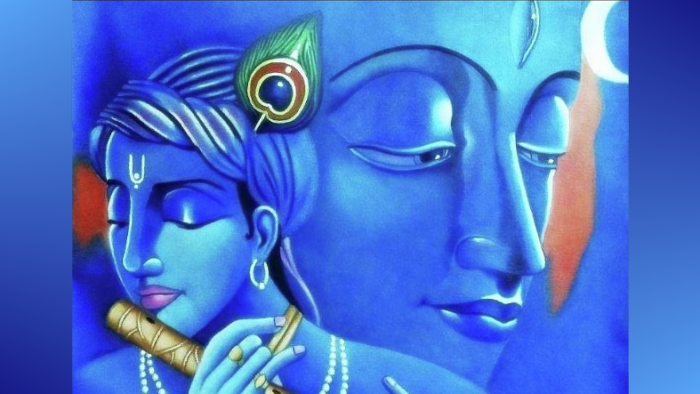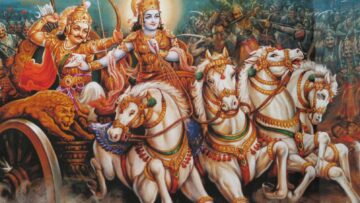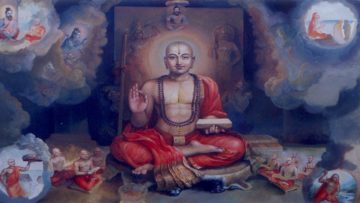It may not go down very well with some people if it is said that Shiva and Parvati are a couple who through their unique conversations, shared with the seekers of Shri Hari the easiest ways of getting His grace and the right path of liberation.
The well-known example is the dialogue in Shri Vishnu Sahasranama. Another best example is the “Anandramayana” that was narrated by Shiva to Parvati.
Shiva the MahaRudra is the Avicchinna Vishnu Bhakta.
It is apt to start knowing about Shiva with the Bhagavadgita Shloka:
रुद्राणांशंकरश्चास्मिवित्तेशोयक्षरक्षसाम्।
वसूनांपावकश्चास्मिमेरुःशिखरिणामहंम्।।
(श्रीमद्भगवद्गीताअध्यायं 10, श्लोकं 23)
Among Rudras, I am Shankara. I am Kubera, the Lord of Wealth, among Yakshas and Rakshasas. I am Agni among the Vasu and of the mountains, I am Meru.
(Sreemad Bhagavad Gita, Chapter 10, Verse 23)
Similarly, it is also appropriate to note the following from SriRudram:
When one chants Sri Rudram, prayer in Yajurveda mentions in its Rishi, Chandas & Devta section: “Shri Sankarshana Moorti Swaroopo Yosaavaadityaha Parama Purusha Sa Esha Rudro Devataa” Meaning the Rudraantargata Naaryaana is being extolled in Sri Rudram, both Chamakam and Namakam.
In Garuda Purana BrahmaKanda, it is clearly stated by none other than Krishna to Garuda:
39-43. Therefore, we are unable to evaluate your merits. Neither I, nor Sarasvati; Siva, Rudra, Sati, the daughter of Daksha, Parvati the daughter of Menaka or Mena, lndra, Indrani, Agni, Yama, Narada, Bhrgu, Vasishtha, Ganesa, Bali, Virata, Bhuman, Sami, Kaseru, Kinnara, manes, gods Gandharvas, Tusyas, kings and their proteges can praise your Virtue.
Brahma is inferior to me (ShriHari) by crones of merits. Vayu being equal to Brahma is inferior to me by the same number. The two are equal to each other in the matter of detachment, in their devotion to Vishnu, in their courage, stability, life strength, restraint and intellect from the origin to the dissolution of the universe. The two are inseparable in the exercise of their power or support.
Garuda, Sesha and Rudra are the ones in the order of Taratamya along with their consorts, SouparNi, VaaruNi and Uma. The following TaratmyaShloka from Mahabharat Tatparya Nirnaya shares the position of MahaRudra in the divine organizational structure of SriMahaVishnu.
vandE viShNuM namAmi Sriyamatha ca BuvaM brahmavAyU ca vandE
gAyatrIM BAratIM tAmapi garuDamanaMtaM BajE rudradEvam ।
dEvIM vaMdE suparNImahipatidayitAM vAruNImapyumAM tA-
mindrAdIn kAmamuKyAnapi sakalasurAMstadgurUn madgurUMSca ॥
The above shloka speaks of the Taratamya starting from Sarvottama Vishnu and enables the person chanting this to offer his/her prayers.
1. Vishnu – Hari Sarvottamma
2. Lakshmi – Nitya Mukta
3. a) Brahma
b) Vaayu
4 a) Saraswati
b) Bhaarathi
5 a) Garuda
b) Shesha
c) Rudra
6 a) SouparNi
b) VaruNi and
c) Uma and other Consorts of Indira and other Demigods like Kama and their Guru Bruhaspati and lastly it enables the person chanting this Shloka to offer Namaskara to his/her Guru.
The reason for sharing the above references is to convey the message from MahaRudra the Mano Niyamaka that he would be at ease in granting boons to his devotees who possess this Jnaanam. The blessings of Umapati MahaRudra are essential to reach the lotus feet of ShriHari.
Unfortunately, the other schools of Vedanta force fit the Vedic Literature as per its tenets and the God Head identified as Sarvottama. Thus, as per the 6 seeking ways approved by Shankaracharya, the seekers can consider other than Vishnu, 5 more Gods as Sarvottama. In this objective world, we cannot comprehend more than one in the top rank in various admission tests, employment tests and other selection processes. How then, it would be tenable to have 5 more Gods (Shiva, Shakti, Ganpati, Surya and Skandha (Murugan) as Sarvottama is a question every seeker must ask his or her Guru. Further, we have Swamy Ayyappa and Shirdi Sai Baba that many seekers pray as Supreme Gods.
After his return from South Africa, MK Gandhi did not go to any Gurukula nor did he approach any Guru. He had no spiritual Guru for himself. All his thinking and models of behavior and conduct is his own. People followed his way of leading life as Ghandhism/Gandhigiri. But this kind of ‘Isms’ cannot stand the test of the times just like Five More ways of seeking suggested by Shankaracharya. ShivaraRaatri exposes this need among seekers, hence this article.
Lord Krishna in Bhagavadgita stated that what the best of the people do will be done by their followers too.
yad yad acarati sresthas
tat tad evetaro janah
sa yat pramanam kurute
lokas tad anuvartate
(Bg 3.21)
Lord Krishna, the Avatara of Lord Vishnu performed Shiva Puja, His consort Rukmini (the Avatara of Aadi Lakshmi) performed Gouri Puja. Similarly, as Rama in Tretayuga performed Shiva Puja at Rameshwaram.
The Taaraka Manthra that Shiva teaches to the souls leaving their mortal bodies when they die in Vaaranaasi is nothing but “Raama”. There are a number of instances where MahaRudra proved his Ananya Bhakti towards his Grand Father ShriHari.
When a devotee worships and makes the offerings with the following jnana, he/she is sure to get the blessings of Shiva:
Umaapati MahaRudraantargata Shri LakshmeeNaarayanapriyathyartham.
This is the ultimate wisdom one must have while worshiping Shiva and Parvati.
The entire Vedic Literature extolls ShriHari as the Supreme Lord of all and all the DemiGods are His first level followers. Our Itiahasas Ramayanam and Bharatam proved the Leela of ShriHari. The best among Puranaas SrimadBhagavatam proved beyond doubt that Seekers need to possess Ananya Bhakti towards LakshmeeNarayana to seek release from the vicious cycle of birth and death.
Yet another proof of Shiva’s devotion towards ShriHari can be experienced in chanting Rudra Gita.
Lord Śiva said to the Pracetās:
“Just execute your kingly duties with a pure heart and chant the prayer I have recited, fixing your mind on the lotus feet of the Lord. That will bring you all good fortune.” (p. 405)
The Rudra-gītā is Lord Śiva’s song to the Supreme Lord, Vāsudeva (Viṣṇu) and is known as the hymn of liberation. These prayers, which are contained in Śrīmad-Bhāgavatam 4.24.33-74, are presented by Lord Śiva to the sons (Pracetās) of King Prācīnabarhi for reaching the ultimate spiritual perfection.
The Supreme Lord (Viṣṇu) says: “Those who will offer Me the prayers composed by Lord Śiva, both in the morning and in the evening, will be given benedictions by Me. In this way they can both fulfill their desires and attain good intelligence.” (SB 4.30.10)
नमःपङ्कजनाभायभूतसूक्ष्मेन्द्रियात्मने।
वासुदेवायशान्तायकूटस्थायस्वरोचिषे॥३४॥
TEXT 34:
namaḥpaṅkaja-nābhāya
bhūta-sūkṣmendriyātmane
vāsudevāya śāntāya
kūṭa-sthāyasva-rociṣe
My Lord, You are the origin of the creation by virtue of the lotus flower which sprouts from Your navel. You are the supreme controller of the senses and the sense objects, and You are also the all-pervading Vāsudeva. You are most peaceful, and because of Your self-illumine.
क्रियाकलापैरिदमेवयोगिनः
श्रद्धान्विताःसाधुयजन्तिसिद्धये।
भूतेन्द्रियान्तःकरणोपलक्षितं
वेदेचतन्त्रेचतएवकोविदाः॥६२॥
TEXT 62:
kriyā-kalāpair idam eva yoginaḥ
śraddhānvitāḥ sādhu yajanti siddhaye
bhūtendriyāntaḥ-karaṇopalakṣitaṁ
vede ca tantre ca ta evakovidāḥ
My dear Lord, Your universal form consists of all five elements, the senses, mind, intelligence, false ego (which is material) and the Paramātmā, Your partial expansion, who is the director of everything. Yogis other than the devotees—namely the karma-yogī and jñāna-yogī—worship You by their respective actions in their respective positions. It is stated both in the Vedas and in the śāstras that are corollaries of the Vedas, and indeed everywhere, that it is only You who are to be worshiped. That is the expert version of all the Vedas.
कस्त्वत्पदाब्जंविजहातिपण्डितो
यस्तेऽवमानव्ययमानकेतनः।
विशङ्कयास्मद्गुरुरर्चतिस्मयद्
द्विनोपपत्तिंमनवश्चतुर्दश॥६७॥
TEXT 67:
kas tvat-padābjaṁ vijahātipaṇḍito
yaste ’vamāna-vyayamāna-ketanaḥ
viśaṅkayāsmad-gurur arcati sma yad
vinopapattiṁ manavaś caturdaśa
My dear Lord, any learned person knows that unless he worships You, his entire life is spoiled. Knowing this, how could he give up worshiping Your lotus feet? Even our father and spiritual master, Lord Brahmā, unhesitatingly worshiped You, and the fourteen Manus followed in his footsteps.
Many devotees of Lord Shiva do not suggest chanting Rudra Gita from Srimadbhagavatam as they are possessed by ajnaana. The seamless reconciliation of all the virtues of all DemiGods from Chaturmukha Brahma onwards (thus the expression BrahmaadiDevetaas meaning Brahma being the first ranked DemiGod in the divine organogram followed by Garuda, Sesha and Rudra and Indra) and the entire Vedic Literature is possible only when a seeker knows with unalloyed Jnaana Bhakti that ShriHari is the Supreme God.
Thus, this ShivaRaatri, it is apt to chant Rudra Gita, Sri Rudra Namakam and Chamakam; and Lingaabhishekam by keeping Mahaarudraantargata Samakarshana Naamaka ShriLakshmeenaarayana.
The following are the Sholokas that I came across about Lord Shiva and devotees of Shiva may like to memorize them (drawn from Sri Vadiraja Theertha’s famous Theertha Prabandham),
चारुकोटीश्वरस्थानंशोभतेयत्पुरत्रयम्।
पुरारिरिवनिर्जित्यध्वजेनाद्यापिजृम्भते॥ ४९॥
॥ Salutations to you, O Neelakanta! You have come to be known as Koteeshwara since you granted happiness to crores of rishis. How then can you not be a Kamadhenu to me, (though I am just) a single rishi? Notes: Sri Vadiraja Tirtha praises the great ability of Lord Shiva by stating how he got the name of Koteeshwara. If one can grant happiness to crores of people, it is obvious that the same person can grant happiness to an individual ॥
सोमेश्वरायसितभूतिविकस्वराय
प्रेमप्रवृद्धगिरिजाहृदिभास्वराय।
तुङ्गोल्लसत्पवनपावितवंशपल्ली
माङ्गल्यहेतुचरितायनमःशिवाय॥ ६८॥
O lord Someshwara! My namaskaras to you lord shiva! one who is enchanting due to white vibhuti, one who shines in the love-filled heart of girijaa, and one who has a history of granting auspiciousness to the village of Vamshapalli (Bidarahalli) which is purified by the excellent winds of the Tungabhadra river.
This Sholoka demystifies the theory of Hari and Hara abhedam and establishes the Bheda.
यदेकेननवध्योsरिःततोहरिहरावुभौ।
सहागतावर्धदृश्यावैक्यंचेत्शत्रुणाजितम्॥ ६१॥
Since that enemy (the demon guha) was invincible by hari or hara alone (this was the boon by brahma that was honored), both of them appeared together (on one half of the moorty). If both of them were the same (i.e. if they had aikya) then the enemy (guha) should have won!
श्रीशैलशिखरावासोभातीशोमल्लिकार्जुनः।
बद्धस्वीयजटाजूटमध्यस्थइवचन्द्रमाः॥ ३॥
Lord isha, the one who resides on the srishaila hill, is white like a mallika flower; He is resplendent just like the moon which is in the middle of his matted hair locks.
फणिगणवरभूषःपार्वतीश्लाघ्यवेषः
खलजनकृतरोषःखण्डितात्मीयदोषः।
सदरुणगिरिवासःशक्रसूर्याद्यधीशः
परिहृतभवपाशःपातुमांपार्वतीशः॥ ३७॥
May the lord of Parvati (Shiva) – one who wears snakes as precious jewels, one whose form is appreciated by Parvati, one who gets angry at evil, one who removes the doshas of his own (devotees), one who is the lord of Indra, Surya and other devatas, one who relieves (us) from the bondage of samsara, one who resides in the excellent Aruna (chala) hill – protect me!
॥ Namahsshivaaya ॥
(Image credit: Bharathi Iyer, fineartamerica.com)
Disclaimer: The opinions expressed in this article belong to the author. Indic Today is neither responsible nor liable for the accuracy, completeness, suitability, or validity of any information in the article.









